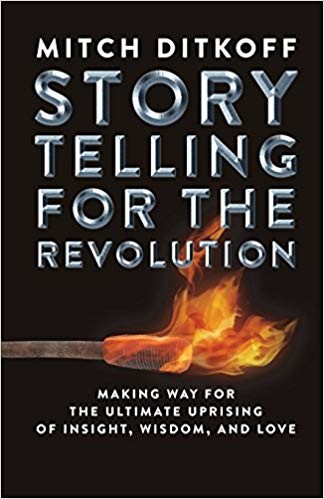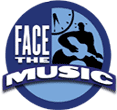If You Want to Jump Start Innovation, This Meme Will Help
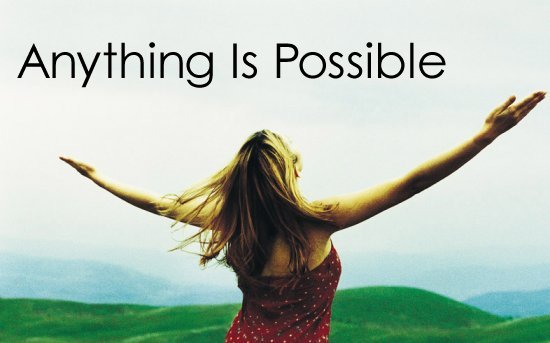
For the past 27 years I have been working "in the belly of the beast" as Che Guevera once said -- corporate America. Along the way, I have met a ton of awesome people: visionary, creative, soulful, committed, and kind people. I have also met quite a few curmudgeons, naysayers, and skeptics. Such is life. No matter where YOU are on this spectrum, this blog post is dedicated to you. ANYTHING IS POSSIBLE! Indeed that's where innovation begins -- in the mind. Your thoughts matter. As do your assumptions, intentions, self-talk, and mojo. Let go of doubt and hesitation. Lean into the possibilities before you! Let it rip!
50 quotes on possibility
Storytelling and the Innovation Mindset
Idea Champions
Posted by Mitch Ditkoff at 12:46 PM | Comments (1)
April 27, 2017You CAN Tell a Book By It's Cover
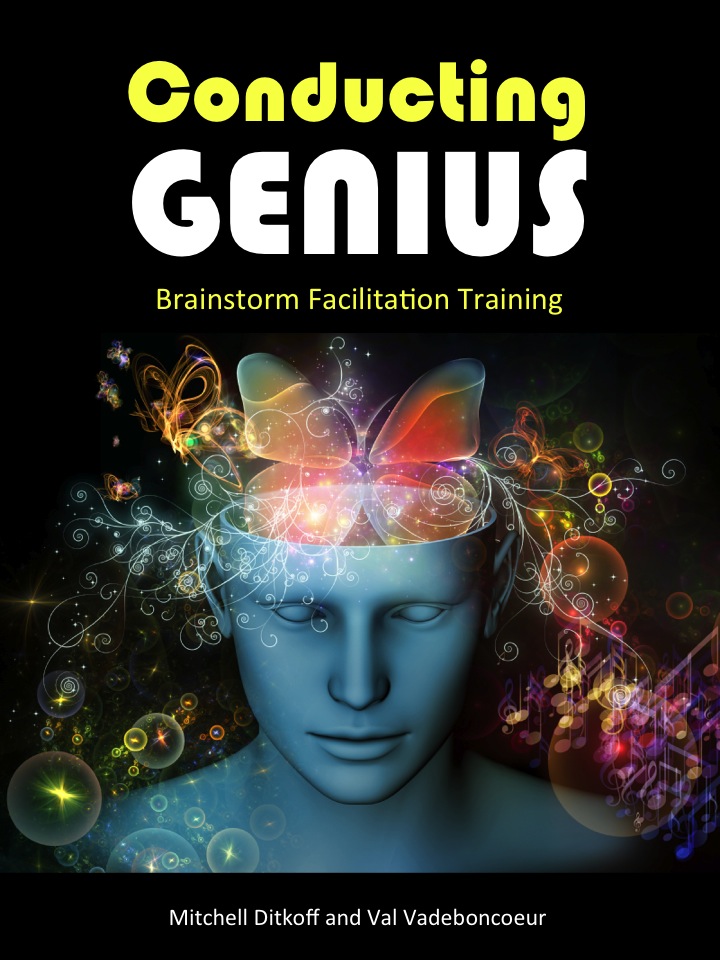
THIS JUST IN! Idea Champions is one of the few companies in the world that teaches people how to become masterful brainstorm facilitators. Since we couldn't agree on which image to use for the cover of the book, we made eight different covers -- and people get to choose the one they like the most. So far, the dog covers have been the most popular. Woof!
Posted by Mitch Ditkoff at 11:27 PM | Comments (0)
April 26, 2017Creativity Late in Life
Lots of people, over 50, think it's "too late" for them to be creative. Not true! You want proof? Check out the slide show above -- excerpts from a fabulous book by Gene Cohen: The Creative Age
Posted by Mitch Ditkoff at 01:39 PM | Comments (1)
The Art of Using Story as a Way to Communicate Big, Hairy Ideas
A priest, a penguin, and a newspaper reporter walk into a bar. The penguin orders a shot of Red Eye. The priest starts juggling three flaming chain saws. The newspaper reporter turns to the bartender, smiles and says: "I know there's a story here somewhere."
And yes, there is. There are stories everywhere. As the poet, Muriel Ruykeser once said, "The world is not made of atoms. The world is made of stories."
Almost everyone in business these days -- at least the people responsible for selling big, hairy ideas -- knows that the difference between success and failure often depends on what kind of story is told -- and how well. Content may be King. But it is Story that built the kingdom. Or as Steve Jobs once put it, "The most powerful person in the world is the storyteller."
The question, these days, isn't whether or not storytelling works. It does. It's worked for thousands of years. If you have any doubt, just ask your local neuroscientist. The question is how do you tell a really effective story -- one that not only informs and entertains, but gets results -- the kind of results that opens minds, influences behavior, and is remembered.
And this is precisely where the proverbial plot thickens. Why? Because most people don't think they know how to tell good story. At least, that's the story they keep telling themselves -- that they don't have the chops or experience to tell a good story. Spoiler alert! Not true.

Social scientists tell us that 65% of our conversations boil down to story -- narrative accounts with a beginning, middle, and end. Throw in a likable hero, a setting, some obstacles, a few juicy details, plot twists, and a resolution, and voila, you've got yourself a story!
Simply put, storytelling is "an unconscious competency" -- something human beings naturally do. The thing is -- we don't know how we do it. Like breathing, for example. Or thinking. Or riding a bicycle. But just because we can't explain how we do it, doesn't mean we're not good at it. Kapish?
You already know how to tell a story. You do. You've been telling stories ever since you were a child. In fact, you tell stories many times a day. On the job. Off the job. Hanging out with your friends. Wherever. Story is in your DNA. Indeed, neuroscientists like to say that the human brain is "wired for story." It's how we make sense of our lives. It's our communication default position. We are storytelling animals. And the more we practice, the better we get.
The simplest explanation of what story is? A narrative -- an account of what happened or what might happen. That account, of course, can be utterly boring ("I woke up. I picked up my dry cleaning. I returned home.") Or it can be utterly captivating -- what every movie you've ever seen or novel you've ever read has tried to accomplish. To capture your attention. To deliver a meaningful message. And to influence what you think, feel, and do.
For the moment, think of storytelling as a big, yummy pot of soup. It smells good. It looks good. And it tastes good. But at first glance, you can't tell what the ingredients are -- or the spices. Do you really need to know every single ingredient if you're being served a bowl of soup from a reliable source? Probably not. But if you're making the soup, you most definitely do. So let's sit down with our penguin, priest, and newspaper reporter for a few minutes and see if we can demystify what this whole mumbo gumbo story thing is all about.

First things first. If you want your story to pack a wallop, you've got to know your audience. If they're allergic to eggplant, don't put eggplant in the soup. If they're vegetarian, lose the chicken. And know your end game -- what it is you're attempting to communicate -- what you want your audience to think, feel, or do differently after listening to you. Whatever message you want to leave them with, be able to boil it down to 10 words or less.
Years ago, this would have been known as your "elevator speech". These days, if you can't deliver your message upon entering an elevator, you're screwed. Think about it. When Steve Jobs launched the iPod, he cut to the chase by distilling his message down to just five words: "1,000 songs in your pocket." That's what the iPod was. Technobabble? No. Overwhelming factoids and data? No. One clean soundbyte surrounded by a compelling beginning, middle, and end. When you think about the story you want to tell, be sure you can distill it down to a memorable meme -- what screenwriters do when they pitch their idea to a movie studio.
Just like the iPod has a shape, so does a story -- the beginning, the middle, and the end, as I've said before, but I'm saying again because I want you to remember just how important structure. It's the spine of your intended result.
The beginning is where you set things up -- the place where you hook the attention of your audience, the place where you set the scene and introduce your hero -- hopefully a likable one. Then you introduce the Big Bad Wolf -- the obstacle, the conflict that begets the drama -- which, in your case, if you are trying to sell a product or service -- might be the competition, a government regulation, or the cost of entering a new market. Get the picture? Someone or something exists and that someone or something wants to move forward towards an inspired goal, but his/her/its path is blocked. Time for nail biting and some popcorn. Hooray for adversity! Without it, there is no story. No Star Wars. No Rocky. No Three Little Pigs.
And the broth of the great story soup you are concocting? What might that be? Passion! Your passion. Your passion for the message you're communicating and your passion for the act of storytelling itself. No passion, no power. No passion, no presence. No passion, no purchase order. It's that simple.

Bottom line, story is all about "emotional transportation" -- the journey you take people on from here to there, from known to unknown, from no can do to what's the next step?"
No matter how logical, linear, or analytical your audience might be, unless you can speak to their heart, you will never win their mind. Yes, of course, if you are making a business presentation, you will need to spice up your story with the fruits of your research, but only enough to keep the story moving, only enough to soothe the savage beast of the left brain. Data is the spice. It is not the main ingredient. If your audience isn't feeling what your saying, it doesn't matter how many statistics you throw their way. As Einstein said, "Not everything that counts can be counted, and not everything that can be counted, counts."
It's Little Red Riding Hood on her way to Grandma's house we care about, not her shoe size or SAT scores.
Other things to be mindful of as your prepare your presentation? Keep your stories short. Speak in the language of the people, not the technologists. No one wants to hear an epic poem. What you're trying to do by telling a story is create an opening to drive the Mack truck of possibility through and maybe pick up a few hitchhikers along the way. You are building a bridge, not a shopping mall.
Lose the complicated back story. "The world doesn't want to hear about your labor pains, they want to see the baby," said Johnny Sain, an American right-handed pitcher for the Boston Braves, born in 1917, who was the runner up for the National League's Most Valuable Player Award in 1948 after leading the league in wins and compiling a lifetime ERA of 3.49 -- the last pitcher to face Babe Ruth). See what I mean? Your team may have put a lot of effort into the project. Months of work. That's great. That's nice. Show us the baby!
And please don't read from your PowerPoint slides. Not only is that boring, it's rude. Borderline, inhuman. There's no way in the world you can build rapport and "read the room" if you are staring at a screen. If you want your audience to look into the future, you've got to look into their eyes, not one boring slide after another.
Here's something to think about: If you really want to get the attention of your audience, "violate expectations." Like what Bill Gates did when, in the middle of a keynote presentation on malaria, he released a bunch of mosquitoes into the room. Talk about buzz! At the very least, infuse your presentation with some visual buzz -- analogies and metaphors that paint a picture for your listeners -- something they can see, not just hear about.
And when you want to crank things up, ask a compelling question or two. Then pause... and listen to the response. The more you listen, the more your audience will listen. Know that a good story is also a good performance. So, unhinge yourself from the dead zone -- the spot on the floor to which you have nailed both of your feet. Move around the room. Vary the lengths of your sentences and the volume of your voice. Gesture. Make facial expressions. Speak to one specific person at a time, not the generic "audience." But above all, trust yourself. If you don't trust yourself, no one else will.
Of course, you can only trust yourself, if you are prepared. So practice your ass off. Know your talking points. Write out a script. Understand the flow of what you want to say, the key milestones along the way and whatever anecdotes and facts you want to include. Then distill the whole thing down to few main points on note cards. Get the story in your bones. Then throw your note cards away. Or, if you absolutely need to hold onto your note cards, glance at them only occasionally. Otherwise, they will become a rectangular 3x5 PowerPoint show in your hand, yet another slow leak in the bucket of your storytelling brilliance.
Remember, there is no formula for telling a good story. Only guidelines. And there is no one right way to tell a story. There are thousands. Maybe millions. Or billions -- each one according to the style and personality of the teller. Your job is not to tell a story like Steve Jobs or Garrison Keillor or Winston Churchill. Your job is tell a story like YOU! And while it is perfectly fine (and often, useful) to read books on storytelling, study TED videos, and attend cool workshops, in the end, all you need to know is this...

You are sitting around the tribal fire with the elders. They want to hear from you. You've been on a big adventure for days, weeks, or even months. You've got important news to share with them, vital insights to reveal, memorable experiences to convey. The survival of the tribe depends it. You're not trying to get promoted. You're not worried about being cast out of the tribe. The only thing that matters is telling your story in a way that informs, inspires, and enlightens.
End of story.
Penguin Photo: Ira Meyer
Storytelling at Work
The Storytelling Workshop
Spark the innovation mindset with story
60 minute radio interview on storytelling at work
Posted by Mitch Ditkoff at 10:34 AM | Comments (2)
April 25, 201710 Ways to Establish a User Friendly Ideation Process
Let's that you and your company value BIG IDEAS -- the kind of ideas that have the potential to change the game, differentiate you from the competition, and spark major business growth.
Let's also assume that you and your company are not at a loss for these big ideas -- that they make their appearance via any number of ways: brainstorming sessions, team meetings, or simply the spontaneous epiphanies of the wild and crazy people down the hall.
That's the good news. The not-so-good-news is that the appearance of these idea are not only random, but often subject to implosion, sabotage, neglect, rabbit holes, premature evaluation, blame, turf wars, and countless other forms of interpersonal and organizational weirdness.
Look at it this way: You are a gardener doing your best to grow watermelons, but the hose you are using to water the watermelons has a lot of holes in it. No matter how often you turn on the faucet, how early you make it out to your garden, or how deftly you point the hose, very little water comes out the other end.

The result? A lot dies on the vine. Yes, it's possible that a sudden rainstorm will save the day, but praying for rain is not a dependable way to ensure a pipeline of powerful, business growth ideas -- the proverbial "front-end of innovation."
If you want to increase the odds of developing big ideas that will turn into new products, new services, and better ways of doing business, you will need to plug the holes or, better yet, invest in a new hose.
What are the holes? The countless ways in which your company's "ideation process" routinely springs leaks.
And here, oh aspiring innovator, is where the plot thickens.
Highly creative people have a tendency to avoid process like the plague, turning a blind eye to anything that requires them to pay attention to an organized approach. To them, this stuff is usually interpreted as a loss of freedom -- the result, they imagine, of upper management trying to micromanage them or over-engineer the one thing they value most in the world -- their free-flowing creativity.
This, of course, is understandable. But it is also extremely short-sighted.
Just like a gardener needs a hose without holes to water their plants, so the creative people in your organization need a hole-free way to bring their ideas to fruition.
Spontaneous idea generation is great. So are brainstorming sessions, late night noodling, and creative off-sites. That's not the problem. The problem is that your company's process for developing and implementing its BIG IDEAS is flawed -- not unlike the O-Ring Space Shuttle Challenger disaster.
But it doesn't have to be that way.
Without over-engineering the spontaneous appearance of creativity in your organization, you can radically increase the odds of big ideas manifesting -- but only if you and your team come up with a sustainable, user friendly ideation process that becomes known and honored by everyone on the scene.
Is there a formula for this? No. Every business is different. Every corporate culture has its own unique ebb and flow. Every team has its own, individual way of operating.
That being said, there are guidelines to be aware of and adapt. That is IF you want to increase the odds of big ideas being conceived, developed, and executed in your company. Let's take a look...

1. COMMUNICATE A CLEAR, COMPELLING VISION: Regularly, let the people in your company know what the ultimate goal of their effort is. When people, swamped by the day-to-day, forget the inspired vision that attracted them to your company in the first place, your hose has sprung its first leak.
What can you do to remind everyone in your organization what the big, hairy, audacious goal is -- the "gold at the end of the rainbow" aspiration that gets everyone out of the bed in the morning?
2. FRAME POWERFUL QUESTIONS: While it's great to have an inspiring goal to aim for, unless you can translate that goal into the kind of meaningful challenges that people can get their arms around, all you are doing is hyping people up.
The more skillful you are at framing your business opportunities as questions that begin with words "How can we?," the more likely it will be that your innovation garden will grow.
That's why British author G.K. Chesterton once said, "It's not that they can't see the solution. They can't see the problem."
How would you frame the question you want your team noodling on this week?
3. WRITE CRYSTAL CLEAR BRIEFS: I'm sure you've heard the phrase "garbage in, garbage out." Yes? Well, this phenomenon also applies to a company's ideation process. If your Brief Writers deliver vague, incomplete, or hard-to-read briefs to brainstormers-to-be, you got trouble in River City.
What can you do to ensure that the people who write brainstorm session briefs in your company are totally on top of their game?

4. IMPROVE YOUR BRAINSTORMING SESSIONS: Most company's brainstorming sessions are hugely ineffective, a kind of hyper-caffeinated Rube Goldberg machine where the same, usual suspects go through the same tired process of either trotting out their pet ideas or jousting with each other and calling it "ideation."
If your next brainstorm session was Spring Training for a baseball team, the field would be tilted, people would be wearing mittens, and various inebriated fans would be streaking across the field. Ouch!
How can you upgrade the quality and impact of your in-house brainstorming sessions?
5. LEVERAGE THE SPONTANEOUS BRILLIANCE OF YOUR WORKFORCE: During the past 25 years, we have asked more than 10,000 people where and when they get their best ideas. Less than 2 percent tell us they get their best ideas at work.
The most common times and places? In the shower. Late at night. Early in the morning. Exercising. Commuting. Or doing something completely unrelated to the task at hand.
Curiously, most companies do not have any kind of process in place for leveraging this naturally occurring idea generation phenomenon. And because they don't, many awesome ideas never get planted in your garden.
How can you encourage your people to honor, capture, and communicate the ideas they are conceiving away from the workplace?
6. COMMUNICATE CLEAR CRITERIA FOR IDEA EVALUATION: Generating ideas is not difficult -- just one of the reasons why the phrase "ideas are a dime a dozen" is so common. What is less common is letting your in-house "idea people" know what the criteria will be used to assess the ideas they conceive.
Identifying and communicating clear criteria before engaging a group of people in a "creative process" is another way to plug one of the big holes in your ideation hose.
In other words, if you are the boss, department head, or team leader, be very clear with your people about how you will be evaluating the ideas they will be generating.
For the hottest project now on the table, what are five criteria you will use to assess the viability of ideas presented to you?

7. CAPTURE AND DOCUMENT IDEAS: Most brainstorm sessions or any kind of intentional ideation processes usually spark a ton of ideas -- some good, some bad, some ugly -- but very few of these ideas are captured.
Even the ones that are captured don't often make it out of the room. A post-it on the wall or a line on a flip chart is a good start, but unless those ideas, like a baton in a relay race, get passed on to the next runner, nothing much happens.
What is your current process for capturing and documenting ideas generated in brainstorming sessions. Is it working? If not, what can you do to improve it?
8. ENSURE MORE DEPENDABLE IDEA EVALUATION: Because most people in your organization are running from one meeting to another, they rarely take the time to slow down, reflect, and evaluate promising new ideas that emerge.
Instead, some kind of voo doo science is applied -- an odd cocktail of mood-driven opinion-making, idea jousting, half-baked conclusions, and whoever-stays-latest-at-the-office-decides.
And while, sometimes, this stuff actually works, it is often a huge hole in your garden hose -- especially since most of your brainstorming sessions are way too rushed and have no time baked into them for idea evaluation.
Who are the likely suspects within your sphere of influence to evaluate ideas, post-brainstorm session, and how can you ensure that they make the time to do so?
9. CREATE A WAY FOR SENIOR LEADERS TO GIVE FEEDBACK: This is a biggie. Ignore this step at your own risk. At the end of the day, your company's senior leaders need a chance to share their feedback -- especially on ideas that are going to require funding or company resources.
This does not need to be an "uh oh" moment, like some kind of surprise IRS audit.
Done well, it can be supremely helpful. Your creative team will get a much-needed reality check. Viable ideas will be refined. And you will radically diminish the odds of the "11th hour squashing of good ideas" syndrome, because your key stakeholders will have had an opportunity -- earlier in the game than usual -- to weigh in and be part of the creative thinking process.
Of course, how these idea feedback sessions are structured and facilitated make all the difference.
What is your concept for how these idea feedback sessions might be structured?
10. MAKE SURE ALL IDEAS ARE MATCHED WITH INNOVATION CHAMPIONS: An idea without a champion is like an orchestra without a conductor. Yes, something will happen. And something, approximately music, will be made, but the chances of that something having major impact will be severely compromised.
Every new idea that merits development needs to have someone attached to it in order to help navigate its way through the invariable obstacles that will arise. This "championing" effort requires tenacity, passion, adaptability, courage, and the willingness to work the system.
What can you do to get a crew of enthusiastic innovation champions up-to-speed and ready for the effort required to ensure that compelling new ideas, in your company, have the best possible chance of seeing the light of day?
Introducing Free the Genie
Metaphors Be With You
How teams can brainstorm successfully online
Posted by Mitch Ditkoff at 08:57 AM | Comments (1)
April 22, 2017FREE ONLINE POLL: How to Improve Your Company's Ideation Process

Here's the simplest way to figure out how to improve your company's ideation process: Enter Idea Champions' FREE IDEATION POLL CONTEST. Just send an email to office@ideachampions and write "Ideation Poll" in the subject line. We'll put your name in the proverbial hat on May 1st and, blindfolded, pick out three winners.
If YOU are one of the winners, we'll send you a link to our ideation poll which you, in turn, will forward to your workforce. A week after that we'll send you the results along with a some useful "food for thought". The value? You will better understand where the holes are in your company's idea generation bucket so you can patch them up or begin figuring out how to get a different bucket. Sneaky marketing shtick from us? None. Nada. Zero. Zilch.
What our clients say about us.
50 quotes on the power of ideas
More about ideation process
Posted by Mitch Ditkoff at 01:34 PM | Comments (0)
April 21, 2017Move the Hole!

I like what Edward deBono once said about the phenomenon of creative people trying to get results, but coming up empty (and I paraphrase). "If you are digging for oil and don't find any, move the hole!"
Pretty simple, eh? Sometimes, it seems as if aspiring innovators get fixated on a particular approach and, no matter what happens (or doesn't), they just keep doing the same old thing over and over again even when experience reveals that their approach is not working.
Of course, it's always possible that other factors are at play:
1. Perhaps the hole you've dug is too shallow and success is only a few shovelfuls away. Digger deeper, then, makes sense. Always possible.

2. Maybe you're digging in the right place, but the tools you're digging with are not the right tools for the job.
3. And, of course, it's always possible that in your effort to discover oil, you don't see the unexpected diamonds and gold coins you stumble upon because everything that is "not oil" is invisible to you.
So, let's make this real for a moment. Think of a project you are working on -- one you have passion for whose results have been slower to materialize than you hoped. Got it? Good. Now answer the following before doing any more digging:
CAN YOU DIG THIS?
1. What are your instincts telling you about how to proceed? Have you dug the hole deep enough? Might it be time for you to move the hole? And if it is the time to move the hole, where might you move it? What are some new approaches to try? Other places to look?
2. If you sense that you haven't dug deep enough -- that you've been a dilettante, slacker, or half-hearted digger for oil -- what can you do to martial your forces and commit to a more rigorous digging effort? And what support, if any, might you need?
3. If, in your digging adventures, you have stumbled upon some unexpected "finds", but dismissed them because you were only focused on oil, how might you extract the value from your accidental discoveries?
By the way, 75% of all product breakthroughs are NOT the result of strategic plans or "intentional effort", but the result of serendipity and "happy accidents" -- what happens when the open-minded innovator stumbles on something intriguing, pauses, and makes the right kind of effort to see if this discovery has value and is worth pursuing.
Posted by Mitch Ditkoff at 02:07 PM | Comments (0)
April 20, 2017The 18th Camel

A father left 17 camels as an asset for his three sons. When the father passed away, his sons opened up the will. The will of the father stated that the eldest son should receive half of 17 camels while the middle son should receive one third and the youngest son one ninth.
As it was not possible to divide 17 into half or 17 by 3 or 17 by 9, the three sons began to fight with each other. Unable to work out their differences, they soon decided to go to a local wiseman, present their problem, and receive his sage counsel.
The wiseman, after contemplating the seemingly unresolvable conundrum, excused himself, went home, and returned a few minutes later with one of his own camels which he added to the 17. This increased the total number of camels now to 18.
Immediately he began reading the deceased father's will aloud to the three contentious sons. Half of 18 = 9, so he gave the eldest son 9 camels. One-third of 18 = 6, so he gave the middle son 6 camels. One-ninth of 18 = 2, so he gave the youngest son 2 camels.

The total number of camels (9 + 6 + 2) given to each of the three sons equaled 17, which left one, extra camel. So the wiseman, with a wry smile on his face, took the extra camel (his!) for himself and rode it home, laughing all the way. Problem solved!
FOOD FOR THOUGHT: Every problem has a solution, even though the solution may not be immediately obvious. The challenge is to find the 18th camel -- the so-called "elegant solution." In order for this to happen we must first let go of the assumption that there IS no solution. There is ALWAYS a solution. Always. It just may not be visible to you in the moment.
What problem of yours do you need to look at from a different angle? What is your 18th camel? And if you can't figure it out by yourself, who can you brainstorm with to arrive at a possible solution?
MitchDitkoff.com
Storytelling as the 18th camel
We teach people how to find their 18th camel
Posted by Mitch Ditkoff at 03:10 PM | Comments (0)
Want to Innovate? Get Hungry!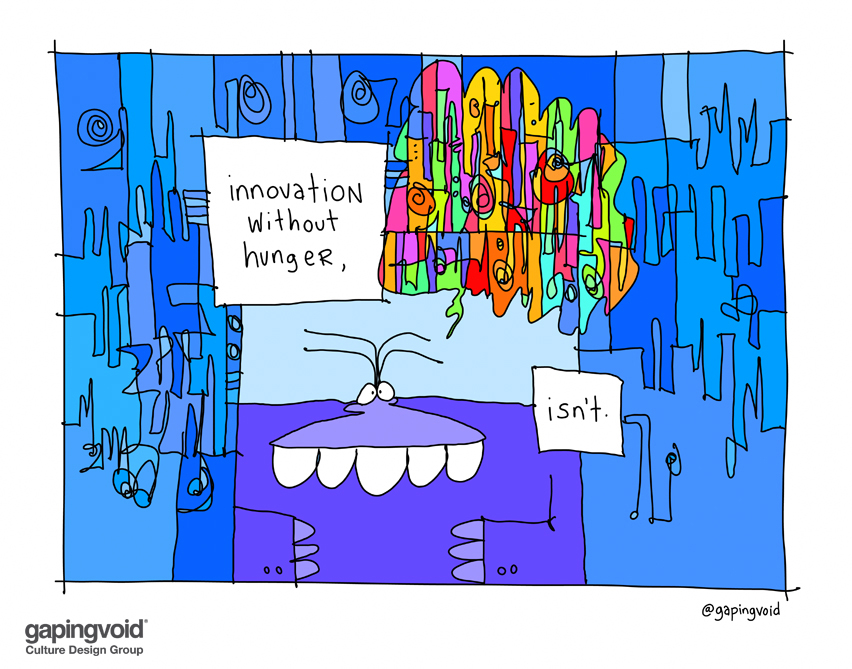
Illustration: gapingvoid
MitchDitkoff.com
Build the appetite with storytelling
Posted by Mitch Ditkoff at 02:40 PM | Comments (0)
April 17, 2017Frequently Asked Questions About Storytelling at Work

1. WHO IS THIS BOOK FOR?
Anyone interested in the power of personal storytelling to awaken, inspire, and communicate a meaningful, memorable message -- especially around "moments of truth" on the job. It's also for forward-thinking business leaders who want to elevate the conversation in the workplace and radically increase the odds of peer-to-peer learning happening on a daily basis.
2. WHY IS THIS BOOK TIMELY?
Because the story being told, these days, is predominantly bad news. Terrorism, war, greed, corruption, political infighting, and corporate collapse rule the airways. But something else is also happening and that "something else" too often remains unspoken -- individual stories of insight, breakthrough, kindness, courage, innovation, learning, and wisdom. The more these stories are told, the faster the world's story will change. As the poet Muriel Rukeyser once said, "The world is not made of atoms. The world is made of stories."
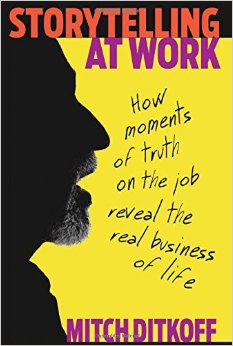
3. WHY IS STORYTELLING SO POWERFUL?
For the same reason why the sun is powerful. It sheds light, gives warmth, and sustains life. Storytelling is the simplest, most direct way to deliver a meaningful, memorable message. Deconstruct any scripture or holy book and you will discover that story is the DNA. Story is how our ancestors, since the beginning of time, communicated their wisdom. And story is how we teach our children. In the business world, where "time is money", storytelling is the most cost-effective way to cut to the chase.
4. WHY DID YOU WRITE THIS BOOK?
Because after 27 years of being an innovation provocateur to a wide variety of Fortune 500, mid-sized, and small companies, I realized that the most effective way to spark the innovation mindset was to tell stories. And while there is always a place for case studies, data dumps, pep talks, and PowerPoint shows, it is storytelling, I have discovered, that gets to the heart of the matter in the least amount of time.
5. HOW DOES STORYTELLING SPARK INNOVATION?
Innovation only happens when a critical mass of inspired, committed people go beyond the status quo in a sustained way. For this to happen, their minds need to be open and their ability to translate thought into action needs to be fully functioning. Story is the fuel for this creative fire -- the direct transmission of soulful soundbytes of wisdom that change individual behavior and, by extension, entire company cultures.

6. I'VE GOT A BUSINESS TO RUN. HOW CAN STORYTELLING IMPROVE MY BOTTOM LINE?
I've got a business to run, too. But all businesses, whether they are Fortune 500 companies or start-ups require an engaged workforce. One of the simplest ways to engage your workforce is to give them vital opportunities to inspire each other. And the simplest way to do that is to encourage them to share their life changing insights via personal story telling. Instead of breaking the bank to bring in "the experts", allow your people to share their deep expertise with each other. Where is their expertise hiding? In their stories -- in the rarely spoken moments of truth that happen to them on the job.
7. HOW CAN MY COMPANY LEVERAGE THE POWER OF STORYTELLING?
Simple. Launch Wisdom Circles, lightly facilitated small group gatherings where open-minded people get a chance to share their insights, best practices, and wisdom with each other. Facilitating Wisdom Circles is easily learned via onsite or online training. 90 minutes is all an aspiring Wisdom Circle facilitator needs to get in the zone.
8. CAN YOU GIVE ME SOME EXAMPLES OF WHAT YOU MEAN BY MOMENT OF TRUTH STORIES?
I'm From Woodstock. Yes, I Am!
The Afghan Cab Driver
It All Began With Balls
Follow Your Feeling, Not the Money Trail
The Uptown Beggar
The Brilliant Complaint Department
Real Moments of Truth on the Job
9. WHAT ARE PEOPLE SAYING ABOUT YOUR BOOK?
"I truly LOVE this book! The last time I read anything this good was Robert Fulghum's All I Really Need to Know I Learned in Kindergarten, and that was 25 years ago! With Storytelling At Work, Mitch Ditkoff has delivered a modern classic on how to communicate with wisdom. Kudos!" -- Rowan Gibson, author of The Four Lenses of Innovation
"Mitch Ditkoff's powerfully written book shows us how storytelling, well done, humanizes the world of work. But even more than that, it helps us pause, go beyond convention, and tune into the deep well of timeless wisdom within." -- Tim Gallwey, Author of The Inner Game of Tennis
"Storytelling at Work is filled with Eureka moments that will spark your creativity and ignite your motivation. Mitch Ditkoff has a magical ability to elevate the routine work of everyday life. Original and deeply insightful!" -- Marshall Goldsmith, author of the New York Times and Wall Street Journal #1 Best Seller, Triggers
"Mitch's storytelling reminds us that the truth is rarely in the bottom right corner of an Excel spreadsheet. It's already inside of us." - Jon Bidwell, Chief Innovation Officer, Chubb Insurance
"Mitch Ditkoff is a master storyteller, weaving tales that not only draw you in, but invite you to see the world with wider eyes. This gem of a book lovingly inspires us to step a little more bravely outside our box." - Susan Stiffleman, Author of Parenting with Presence
The Storytelling at Work workshop
Sparking Innovation with storytelling
MY FORTHCOMING BOOK: Storytelling for the Revolution
MitchDitkoff.com
Posted by Mitch Ditkoff at 02:51 PM | Comments (2)
April 16, 201714 Ways to Get Breakthrough Ideas
There's a lot of talk these days about the importance of innovation. All CEOs worth their low salt lunch want it. And they want it, of course, now.
What sparks innovation? People. What sparks people? Inspired ideas that meet a need, whether expressed or unexpressed -- ideas with enough mojo to rally sustained support. Is there anything a person can do -- beyond caffeine, corporate pep talks, or astrology readings -- to quicken the appearance of breakthrough ideas?
Yes, there is. And what follows are 14 catalysts -- simple guidelines, principles, and approaches that will help you on your way.
1. FOLLOW YOUR FASCINATION
If you find yourself fascinated by a new idea, chances are good that there's something meaningful about it for you to consider. Fascination, quite simply, is nature's way of getting our attention. Well beyond seduction or attraction, it's an indication that we are being called. Out of the thousands of ideas with the power to capture our imagination, the felt fascination for one of them is a clue that there's something worthy of our engagement.
Don't dismiss it as trivial. Give it room. Give it time to breathe. Honor it. If you have any doubt, consider the origins of the word "fascination". It comes from the Latin "fascinus," meaning to be "enchanted or delighted."
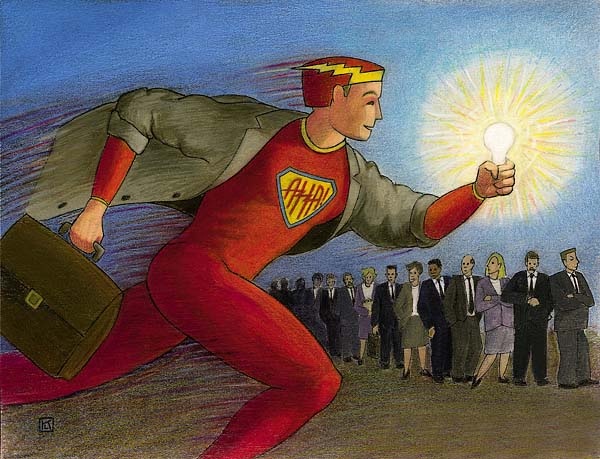
What enchants or delights us is sacred -- or could be sacred -- a clue that something significant is knocking on our door. Indeed, if we are willing to let fascination grow inside us, a kind of immaculate conception can occur, the illogical, miraculous becoming pregnant with possibility -- the bodily expression of the phenomenon that you are here to birth something extraordinary.
The idea is simply the first "waaaaaaah" to get you to notice.
What new idea is fascinating you? What new possibility has captured your attention? In what ways can you honor this inspiration today?
2. IMMERSE
Breakthrough ideas, like telemarketers or Jehovah's Witnesses, have a curious habit of showing up at odd times. And because they do, we're not always ready to receive them. To complicate matters, chances are good that when they do show up, we are multi-tracking our little tushies off -- checking email, microwaving dinner, or looking for our Smart Phone amidst the half-folded laundry. Not exactly the pre-conditions for breakthrough.
The alternative? Immersion -- the act of becoming completely involved or absorbed in something -- engrossed, enthralled, or preoccupied."
If you want to radically increase your odds of originating breakthrough ideas, you will need to immerse. Don't be a chicken, be a hen! Baby chicks break through the shell separating them from flight not because their mothers are rushing off to meetings on parenting skills, but because their mothers are immersed in the act of hatching. Mommy is sitting in one place for a looooooooong time. And baby chick is also sitting (curled up) in one place for a looooooooong time.
At Google, employees are given 20% of their time to immerse in projects that have nothing seemingly to do with their so-called day job. At 3M, it's 15%. W.L. Gore gives employees a half a day each week to immerse in projects that fascinate them.
Look at your calendar. Block out some time to focus on the development of your most inspired idea or venture. Unplug! Incubate! Hatch! Immerse!
3. TOLERATE AMBIGUITY
Breakthrough ideas are not always the result of a revolutionary Eureka moment. On the contrary, they are often the result of an evolutionary series of approximations or failed experiments. When Thomas Edison was asked how it felt to fail 800 times before coming up with tungsten as the filament for the light bulb, his answer was a revealing one.
"Fail?" he said. "I didn't fail once. I learned 800 times what didn't work."
Edison had the ability to tolerate ambiguity -- to "not know." Like most breakthrough thinkers, he had the ability to dwell in the grey zone. Confusion was not his enemy.
"Confusion," explained Henry Miller, "is simply a word we have invented for an order that is not yet understood."
If you are attempting to birth a breakthrough idea, get comfortable with discomfort. Give up your addiction to having all your ducks in a row, at least in the beginning of your discovery process. People may think you're a quack, but so what? Your chances of birthing a breakthrough idea (and result) exponentially increase the more you are able to tolerate ambiguity.
What new idea of yours is bubbling on the brink of breakthrough? In what ways can you stay with it, even if something in you is impatient for a breakthrough?

4. MAKE NEW CONNECTIONS
True creativity rarely happens in a vacuum. On the contrary it is the product of two or more variables connecting in a new way. It happens all of the time in nature. Water, for example, is really just the connection between hydrogen and oxygen. It happens in the human realm as well. Roller blading is nothing more than the connection between ice skating and roller skating. MTV? Nothing more than the connection between music and television. Drive in banking? Car + banking.
The originators of these breakthrough products didn't pull rabbits out of hats. All they did was see a new, intriguing (and potentially commercial) connection between already existing elements.
Why don't more of us make these kinds of connections? Because we usually stay within the confines of what we already know. We live in a box of our own creation -- whether that box be defined by our nationality, profession, concepts, cubicle, or astrological sign.
The more we are willing to get out of this box, the more likely it will be that powerful new connections will reveal themselves to us -- uncommon linkages between this, that, and the other thing -- kind of the way it was for Johannes Gutenberg when he noticed a previously undetected connection between the wine press and coin punch. And so the printing press was born.
Make three parallel lists of ten words. The first list? Nouns. The second list? Verbs. The third list? Adjectives. Then look for intriguing new connections between them.
5. FANTASIZE
In 1989, Gary Kasparov, the Soviet Union Grand Chess Master, played a two game match against "Deep Blue," the reigning supercomputer of the time. Kasparov won easily. When asked by the media what his competitive advantage was, he cited two things: intuition and the ability to fantasize. (And this, from a master strategic thinker!)
Few of us are ever encouraged to fantasize -- a behavior most commonly associated with children or perverts. And yet, fantasizing is exactly how many breakthrough ideas get their start -- by some maverick, flake, or dreamer entertaining the seemingly impossible.
I find it curious that business leaders want their employees to come up with fantastic ideas or solutions, but they don't want their employees to fantasize. And yet, the words "fantastic" and "fantasy" come from the same linguistic root, meaning to "use the imagination."
Think of a current challenge of yours. What would a fantasy solution to this challenge look like? What clues does this fantasy solution give you?
6. DEFINE THE RIGHT CHALLENGE
"It's not that they can't find the solution," said G.K. Chesterton, the renowned American philosopher and writer, "They can't find the problem!"
Translation? Most people, in their rush to figure things out, rarely spend enough time framing their challenge in a meaningful way. If they owned a GPS, they'd fail to take the time to program in their destination because they were so much into the hustle of getting out of town. Coming up with the right question is at least half of getting the right answer.
If you want a breakthrough idea, begin by coming up with a breakthrough question -- one that communicates the essence of what you're trying to create.
State your most inspired challenge or opportunity as a question beginning with words "How can I?" Then write it three different ways. Which is your real question?

7. LISTEN TO YOUR SUBCONSCIOUS
If you study the lives of people who have had Eureka moments, you'll note that their breakthroughs almost always came after extensive periods of intense, conscious effort. They worked, they struggled, they noodled, they gave up, they recommitted -- and then the breakthrough came. And often at unexpected moments. They weren't buying lottery tickets at their local deli, hoping to win a breakthrough fortune, they were digging for treasure in their own back yard.
Rene Descartes got the idea for the Scientific Method in a dream. Richard Wagner got the idea for Das Rhinegold while stepping onto a bus after long months of creative despair. Einstein used to conduct "thought experiments" (a fancy name for daydreaming) whenever he got stuck.
In other words, the conscious mind works overtime in an attempt to solve a problem or achieve a goal. Unable to come up with the breakthrough, the challenge gets turned over to the subconscious mind which then proceeds to figure it out in its own, sweet time.
Of course, all of this assumes that we are listening to the promptings of our subconscious mind.
This week, keep a log of your most inspired ideas, intuitions, and dreams. At the end of the week, review your log. See what insights come to you.
8. TAKE A BREAK
If you want a breakthrough, you will need to take a break. True innovators rarely follow the straight and narrow path. Not only do they march to a different drummer, they're often not even on the same playing field as most people.
Take Seymour Cray, for example, the legendary designer of high-speed computers. He used to divide his time between building the next generation super computer and digging an underground tunnel below his Chippewa Falls house. Cray's explanation of his tunnel digging behavior is consistent with the stories of many other creatives -- inner-directed, boundary-pushing people who understand the need to go off-line whenever they get stuck.
Bottom line, whenever they find themselves struggling with a thorny problem, they walk away from it for a while. They know, from years of experience, that more (i.e. obsession, analysis, effort) is often less (i.e. ideas, solutions, results).
Explained Cray, "I work for three hours and then get stumped. So I quit and go to work in the tunnel. It takes me an hour or so to dig four inches and put in the boards. You see, I'm up in the Wisconsin woods, and there are elves in the woods. So when they see me leave, they come back into my office and solve all the problems I'm having. Then I go up (to my lab) and work some more."
Next time you find yourself stuck on a thorny problem or project, walk away from it for a while. Stay conscious of new solutions coming to you during this down time.
9. NOTICE AND CHALLENGE PATTERNS AND TRENDS
There are many people these days who make their living from the pattern recognition business: futurists, meteorologists, air traffic controllers, and stock brokers just to name a few. And while their success rates may not always be 100%, it is clear that whatever success they enjoy is intimately tied to their ability to notice patterns and then interpret those patterns correctly for the rest of us.
The same holds true for breakthrough thinkers. The only difference? Breakthrough thinkers often hit the gravy train by challenging old patterns and then reconfiguring them in new ways.
"The act of creation," said Picasso, "is first of all an act of destruction."
"The genius," said American painter, Ben Shahn, "is merely the one able to detect the pattern amidst the confusion of details just a little sooner than the average man."
What trends in the marketplace most intrigues you? In what ways might these trends shift in the coming years -- and how might your most inspired idea be in sync with this imagined shift?

10. HANG OUT WITH A DIVERSE GROUP OF PEOPLE
Years ago Sony used to insist that their engineers spend at least 25% of their work time out of the office and mixing it up with people outside of the four walls of their industry. Keepers of the innovation flame at Sony understood that diverse inputs were essential to the origination and development of breakthrough ideas.
Unfortunately, most of us tend to stay within the intellectual ghettos of the familiar. We hang out with the same people day and night -- usually people who either agree with us, report to us or, through some indefinable act of karma, are joined to us at the hip.
If you want to increase your chances of getting a breakthrough idea, you will need to break the bonds of the familiar. Hang out with a different crowd. Go beyond the usual suspects. Seek the input of oddballs, mavericks, outcasts, or, at the very least, people outside your field. If you can let go of your need for comfort and agreement, you will find yourself catapulted into new ways of seeing, thinking, and acting -- all precursors to breakthrough ideas.
Make a list of ten people outside of your traditional posse that you can spend some time with this month.
11. BRAINSTORM
Breakthrough thinkers are often rugged individualists. They believe in their inalienable rights to think for themselves. They value their opinions, their perspectives, and their innate creativity. Their biggest fear is group think. All well and good.
But there is an important distinction to be made between group think and the phenomenon of inspired individuals getting together to spark each other's brilliance. Indeed, most great breakthroughs are more about inspired collaborations than they are about lone wolf genius.
Think Bill Gates and Paul Allen (Microsoft), Steve Jobs and Steve Wozniak (Apple), Sergey Brin and Larry Page (Google), David Filo and Jerry Yang (Yahoo), Watson and Crick (DNA), Lennon and McCartney (the Beatles), Hewlett & Packard.
All you need to do is frame a meaningful question, invite the right people, and facilitate the process for helping your think tank creatively jam. If you are not the right person to facilitate, you probably know someone who is. Ask them.
What is the topic of your next group brainstorm? Who will you invite? Who will facilitate? When?
12. LOOK FOR HAPPY ACCIDENTS
Breakthrough ideas are often less about the purposeful act of inventing new things that it is the art of noticing new things that happen accidentally -- those surprise moments when the answer is revealed for no particular reason.
The discovery of penicillin, for example, was the result of Alexander Fleming noting the formation of mold on the side of a Petri dish left unattended overnight. Vulcanized rubber was discovered in 1839 when Charles Goodyear accidentally dropped a lump of the polymer substance he was experimenting with onto his wife's cook stove.
Breakthroughs aren't always about inventions, but about the intervention required to notice something new, unexpected, and intriguing. For this to happen, you will need to let go of your expectations and assumptions and get curious. Give up being an expert. Let go of the past. See with new eyes.
What failed experiment or unexpected outcome might be interesting for you to reconsider?

13. USE CREATIVE THINKING TECHNIQUES
I live in the Northeast. In the Winter, it's common for old cars, especially on very cold mornings, not to start. When this happens, the best thing you can do is get a jump start. All you need are jumper cables and another car that's got its motor running.
Creative thinking techniques are like jumper cables. They spark ignition. They turn potential into kinetic energy. They get you going when you're stuck. If you're looking for a breakthrough idea, perhaps all you need is a jump start. That jump start can take many shapes. It can be a classic, creative thinking technique, of which there are many. It could be a "creative thinking coach" or a favorite book, or a quote. Ultimately, it doesn't matter what medium you choose, just as long as you choose something to get your motor running.
What is one creative thinking technique you might use the next time you need a jump start on the job?
14. SUSPEND LOGIC
Perhaps Einstein said it best when he declared: "Not everything that can be counted counts; and not everything that counts can be counted."
He was referring, of course, to the part of the human being that knows intuitively -- the part that is tuned in, connected, and innately creative. Kids live in this place. The rest of us just visit, preferring the left-brained world of rationality, logic, linearity, and analysis.
On some primal level, we're all from Missouri. We need proof. And while there is nothing inherently wrong with gathering data, the addiction to it subverts our ability to originate breakthrough ideas.
We know this. That's why we go to the movies, the pub, watch TV, read novels, dial 900 numbers, and daydream. We seek an altered state, one that is free of the normal gravity of daily life. That's why movie makers ask us to suspend disbelief. That's why brainstorm facilitators ask us to suspend judgment. That's why women (innately intuitive as they are) ask the men in their lives to stop being so damn practical for a change and actually feel something.
It is in this state of suspension that our innate creativity is free to percolate to the surface -- over, under and around all of the left brained guardians at the gate. And so... if you want to really birth a breakthrough idea, you too will need to enter into this state -- at least in the first phases of your new venture. Suspend judgment. Suspend evaluation. Suspend your addiction to the practical. What exists on the other side is fuel for the fire of your untapped creativity.
What can you do this week to suspend practicality, logic and rationality in service to birthing your big idea?
Posted by Mitch Ditkoff at 04:39 AM | Comments (1)
April 15, 2017Winning the Fundraising Game

If you are a mover and a shaker for a non-profit, arts organization, start up, or other capital-constrained enterprise, chances are good that you spend way too much time thinking about the "F" word -- fundraising. While the mission of your organization may be highly expansive, the money is takes to support that mission is, all too often, highly contracted -- especially these days, with government cut backs and an uncertain economy.
Enter Idea Champions' Winning the Fundraising Game, a thought provoking, custom designed, 4 - 8 hour creative thinking session that cuts through the "same old same old" syndrome and catalyzes bold, new, actionable possibilities.
Unlike most brainstorming sessions, Winning the Fundraising Game does not just focus on the generation of ideas -- or what some innovation mavens refer to as divergence. It also focuses on convergence -- what it takes to turn those bold, new ideas into measurable results.
HOW WE GET RESULTS
1. NEEDS ASSESSMENT: The first thing we do is learn about your organization's past and current fundraising efforts -- what's worked, what hasn't, and why. At the same time, we also learn about your organization's culture, so the design of our session is appropriate to the mood and mindset of participants. Our needs assessment process includes one-on-one phone interviews with a cross section of key stakeholders, as well as an online poll that gives all participants a chance to share their perspective.
2. CUSTOM DESIGN: Once we're clear about your hoped for outcomes, we design the session. Variables that impact the design include the number of attendees, length of session, meeting space, collective sense of urgency, goals, and the willingness of participants to go beyond the status quo.
3. FACILITATION: Idea Champions consultants are highly experienced facilitators of group process. Since 1987, we have been designing and leading dynamic creative thinking, teambuilding, visioning, and leadership development sessions for almost every industry on planet earth, including telecommunications, media, retail, pharmaceutical, health care, high tech, government, education, public relations, manufacturing, and non-profit.
4. FOLLOW-UP: Our support for your team of fundraising mavens does not necessarily end when the last person leaves the room. We offer all our clients a variety of simple ways to ensure that meaningful follow-up happens. This includes the generation of a post-session brainstorm report, reality check conference calls, and coaching.
As described on our website
Idea Champions
MitchDitkoff.com
Posted by Mitch Ditkoff at 12:08 PM | Comments (0)
April 14, 2017Listening is a Superpower
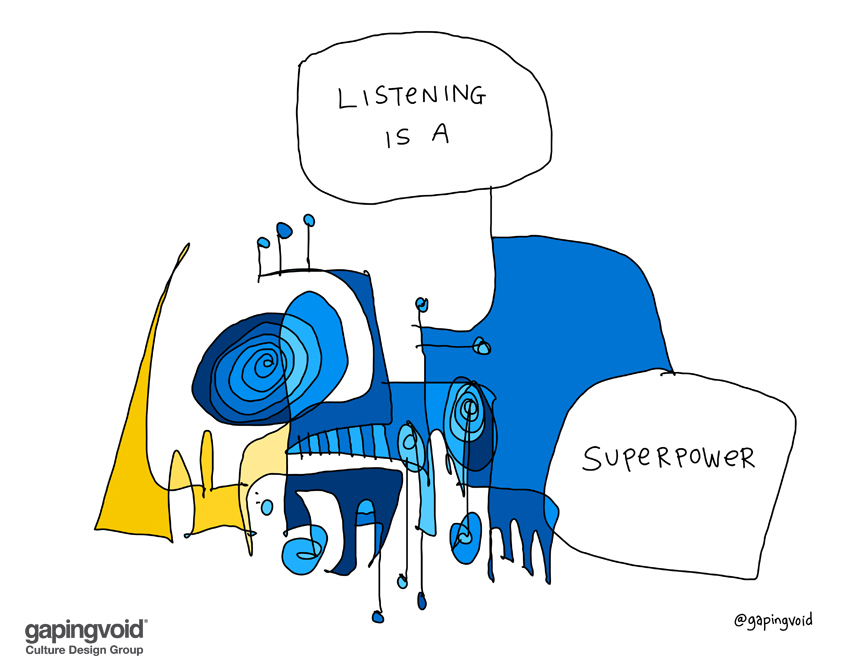
As an innovation provocateur and storyteller, I am continually fascinated at how rare real listening is in most organizations. Everyone seems to be moving so fast or just WAITING for their turn to speak, that real listening rarely happens. Methinks, it goes all the way back to our childhood where we were deeply appreciated for speaking our first word, but never appreciated for the first time we listened.
24 quotes on good communication
Illustration: gapingvoid.com
MitchDitkoff.com
Posted by Mitch Ditkoff at 09:00 AM | Comments (0)
April 13, 2017The World Storytelling and Innovation Tour
Posted by Mitch Ditkoff at 04:39 AM | Comments (0)
April 08, 2017How to Ensure that Your Next Conference Will Be a Big Success

If you have a big conference coming up and want to make sure it is has major impact, Idea Champions can help. We design and facilitate conferences that make a big difference -- memorable events that are totally engaging, enjoyable, and radically increase the odds of your conference outcomes sustaining over time. Here's how we do it:
1. VISION CLARIFICATION: First things first. If you are going to invest a bunch of time and money into a company offsite, it makes sense to get completely clear about your hoped for outcomes -- and how you will measure success. Which is why our conference services begin with an in-depth conversation with you. You share your vision with us. You share your concerns, too -- along with the pros and cons of past conferences. We listen, address your concerns, and explain how we can help you turn your vision into reality.
2. NEEDS ASSESSMENT: After we get your input, we'll connect with a cross-section of conference attendees. Yes, we want to know what you think, but we also want to know what they think -- especially since they are the majority. Towards that end, we'll interview and poll selected attendees (and customers, too) -- providing you with a crystal clear picture of the forces at work and how they are likely to impact your conference design.
3. LEARNING PLANS: Will there be chicken at your conference? Muffins? Nametags? Yes, there will be. But there will also be too many people just taking up space, assuming their role is to be spoon fed by presenters. Not a good idea. If you want your offsite to really make a difference, you've got to change the game and create a learner-directed approach. Towards that end, long before your conference begins, attendees will commit to three things they want to learn at your event, three people they want to learn it from, and three things they can teach. All of this will be summarized in a Conference Playbook that everyone will receive -- a simple way to ensure meaningful, real-time, peer-to-peer learning.
4. AGENDA DESIGN: Most corporate conferences are like American cities. Sprawl rules the day. Someone speaks too long. Then someone else speaks too long. Slides are shown. Maybe there's a cheesy icebreaker. And then people enter into a trance state. No matter what the particulars of your event, there's one thing you can definitely count on -- people will be sneaking peeks at their smart phones under the table and wondering what's for lunch. The missing piece? A well-crafted conference design that ensures maximum engagement, teamwork, creativity, networking, commitment, fun, and follow-up. Hint: We know how to do this.
5. STORYTELLING: We know there's a lot of bright spots in your company — best practices, lessons learned, and past successes. That's the good news. The not-so-good news? Too few of these bright spots are known. That's why the conferences we design include a healthy dose of storytelling -- not just from our presenters to your attendees, but from your attendees to each other. Months before your event, we'll identify a mix of in-house successes and coach selected attendees how to present these successes, in story form, from the main stage.
6. PROJECT MANAGEMENT: Every conference has a lot of moving parts. Usually, your conference planner is responsible for these moving parts. But when Idea Champions gets into the mix, there will be other moving parts your conference planner will not be familiar with -- conference elements that will need to be managed by someone, and that someone is us. Our Project Manager will work closely with your conference team to make sure that all of the puzzle pieces fit together and that nothing falls through the cracks. And if a crack opens up, we'll fill it fast.
7. COPYWRITING: Let's assume, for the moment, that you are totally clear about the purpose and process of your conference. Congratulations. But even if you are clear, there's a good chance that the rest of your organization is not. Why? Because, historically, your pre-conference communications have been an odd mix of unclear, uninteresting, and unread. That's why our conference services include our world-class copywriting and editorial services. We can help you -- oh over-committed future client of ours -- get the word out in a painless, elegant way.
8. FACILITATION: You know the old expression "If a tree falls in a forest and there's no one around to hear, did it make a sound?" Well, there's a modern day correlative to that: "If a conference happens and no one is listening, was your money well spent?" The answer is a resounding NO, but we can fix that. On site, the Idea Champions team will do everything possible to ensure that participant engagement is at an all-time high. Based on your need and budget, we can do any or all of the following: MC, facilitate icebreakers, deliver keynote presentations, lead team building challenges, get people out of the box, spark idea generation, facilitate breakout sessions, stage manage, create slide shows on the fly, and work closely with your team to adapt the agenda, as needed.
9. TAKEAWAYS: When attendees leave your conference, you want them to leave with more than a t-shirt, hat, and water bottle. You want them to leave with the kind of takeaways that will help them continue to live the spirit of your event. Guess what? That's what we provide -- decks of innovation-sparking cards, decks of team building cards, books that foster a culture of innovation, booklets that spark idea generation, and a selection of more than 50 handouts on innovation, change, leadership. storytelling, and creative thinking. Plus, we create a private page for your organization on our website with links to more than 20 videos and articles that will keep your people on top of their game long after your event is over.
10. FOLLOW-UP PLANNING: One of the biggest complaints we hear from our clients is that, no matter how good their conferences may be, meaningful follow-up rarely happens. Sound familiar? This is why we will work closely with you and your design team, on the front end, to strategize an easy-to-implement follow-up plan that will significantly increase the odds of conference outcomes sustaining over time. You're not the only one who wants results. We do, too.
Idea Champions
MitchDitkoff.com
Comments from our most recent conference
Posted by Mitch Ditkoff at 10:23 AM | Comments (0)
April 06, 2017Business Casual Conferences from the Future? Dress Code Optional.
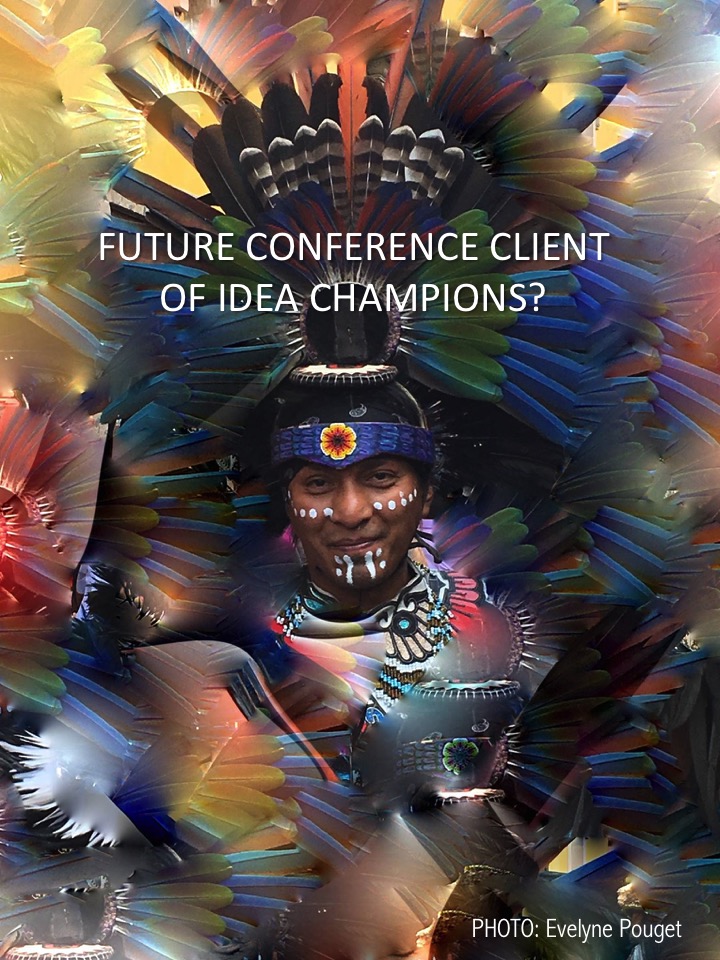
Idea Champions has just launched a new conference design and facilitation service. If you have a big conference coming up and you want it to have major impact, we're your resource -- savvy conference designers, team builders, keynote speakers, facilitators, innovation catalysts, edutainers, and big meeting guides.
Photo: Evelyne Pouget
Idea Champions
MitchDitkoff.com
Posted by Mitch Ditkoff at 12:39 PM | Comments (0)
VIDEO: The Power of Storytelling in the Workplace to Spark Innovation
Click here for a 33-minute interview of Mitch Ditkoff talking about the power of storytelling to ignite innovation, insight, and wisdom in the workplace. This link will expire on April 9th. Enjoy!
MitchDitkoff.com
IdeaChampions.com
BOOK: Storytelling at Work
Posted by Mitch Ditkoff at 11:55 AM | Comments (0)
April 05, 2017You Have Stories to Tell
Here is the retelling of an old tale I first heard from Prem Rawat. The story can be interpreted in a number of ways. For this particular moment, I am telling the story to draw your attention to the fact that within you, hidden from sight, there are many wonderful stories still to be told. I encourage you to tell them.
MitchDitkoff.com
Posted by Mitch Ditkoff at 07:15 AM | Comments (0)
April 04, 2017When You Want Your Next Big Conference to Be a Breakthrough
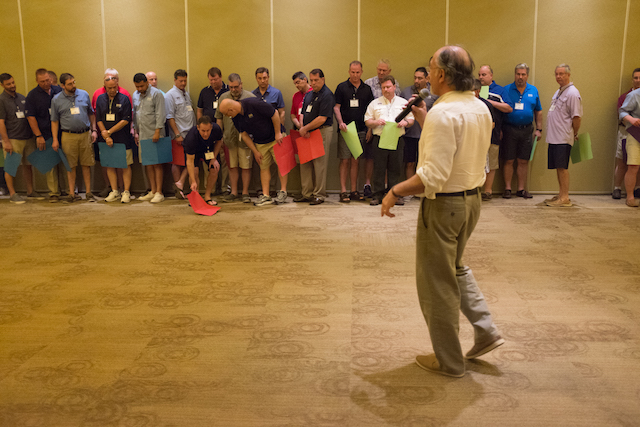
Nine months ago, I received an intriguing email from Rich Nugent, CEO of a fast-growing and forward thinking commercial roofing company, Nations Roof. "I need a breakthrough" read the subject line.
The next day Rich and I talked about his desire to make sure his annual conference made a big difference in the trajectory of his organization. Rich not only wanted to establish more unified commitment among his 20+ business units, he wanted to launch a new initiative that would jump start his vision for Nation's Roof to become the "Mercedes of Customer Service" in his industry.
But for that to happen, Rich knew that something needed to shift, especially given the fact that there were so many sub-cultures in his organization. Long story short, Idea Champions worked with Rich and his team (staring nine months before the conference) to get all quacking ducks in (an out) of row. Then one of us (Mitch) made his way to Costa Rica to facilitate the process.
Below is the first wave of comments Idea Champions has received from some of the 61 conference participants.
COMMENTS FROM CONFERENCE PARTICIPANTS
"As the CEO of a company with offices and sales professionals throughout the USA, it's a very difficult cultural environment. The value of collaboration to our own growth and profitability is obviously enormous, but to our customers it's immeasurable. After several annual meetings where we did our best to communicate a unified message, we thought it was time to get help. So we made the decision to bring in Mitch Ditkoff of Idea Champions to facilitate the communication of urgency and opportunity to our organization. It was the right decision. I never saw our people so engaged. I have been told by the majority of attendees how much they got out of this meeting. They have expressed that they get it now and feel not only a greater commitment to the company, but to each other. Mitch and Idea Champions will be a part of our future growth and ability to provide high quality services to our customers." -- Rich Nugent, CEO, Nations Roof
"Mitch Ditkoff's facilitation of our 2017 conference showed us how authentic, interactive storytelling can spark creativity and improve company culture." - Jill Tackett, Director of Strategic Initiatives
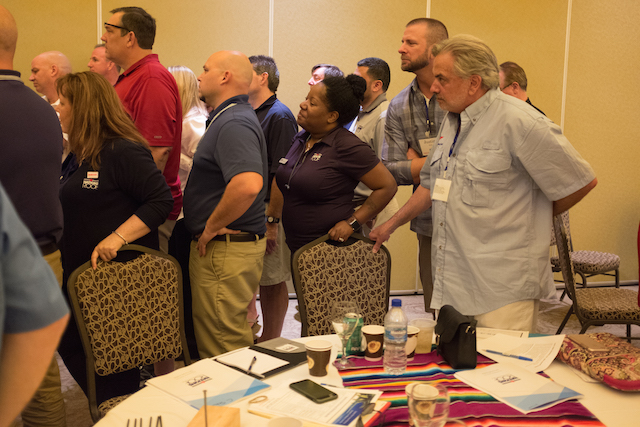
"The biggest impact made by Idea Champions at our annual meeting was helping Nations Roof and it's many business units change the way we look at things. Because, as you know, when you change the way you look at things, the things you look at change. We took a great step forward in our evolution, as a company, thanks to Mitch." - Larry Morgan, President, National Sales
"Great job of facilitating our annual meeting! You kept it lively and interesting, while guiding us to apply the ideas and business principles that we were discussing. The stories and plans we generated at the conference will drive our strategic plans for years to come. And thanks, also, for the many new ideas you helped us generate. I can't wait to get started on them." - John Geary, Chief Marketing Officer
"The Storytelling approach you used at our corporate conference brought our extremely diverse group together like no one or nothing ever has." - Doug Ingle, Regional VP of Sales
"This past week, in Costa Rica, Mitch lead our group of 61 employees to a place of unified commitment. His ability to build a "one-team" mentality brought our people much closer together, helped us work better as a team, and clarified our goals. Mitch's group process and facilitation style opened our eyes to areas we need to focus on in order to meet our goal of providing extraordinary service to our customers." - Nick Little, National Service Manager

"I enjoyed your presentation very much. It was interactive and engaging rather than numbers and charts." - Dave Hinkley, President, North
"The last few annual events we struggled to bring a group together that interacts more or less once a year to accomplish something constructive. But this year's meeting was different. I really enjoyed your facilitation. You kept me engaged and I really believe that all of us benefited from your process. The River Crossing activity was very insightful. It hit the nail on the head for us." - Steve Miller, EVP, Carolina
"I enjoyed our three sessions with Mitch. He kept things lively and thought provoking. He focused our group on obtaining the goal of crossing the goal line together in our company's quest to be the best in service to our customers." - Bruce McCrory, Operations Manager, Gold Coast
"I enjoyed our time together immensely. Now back to the salt mine." - Mike Johannes, President, East

"Thank you for a great conference in Costa Rica. Your presence and coaching really made it a great experience." - Doug Duncan
"Thanks for the opportunity to think in creative ways to improve our business." - Kent Tolley, President, Mountain
What our other clients say
MitchDitkoff.com
IdeaChampions
Posted by Mitch Ditkoff at 02:53 PM | Comments (0)
April 02, 2017Ready, Fire, Aim!
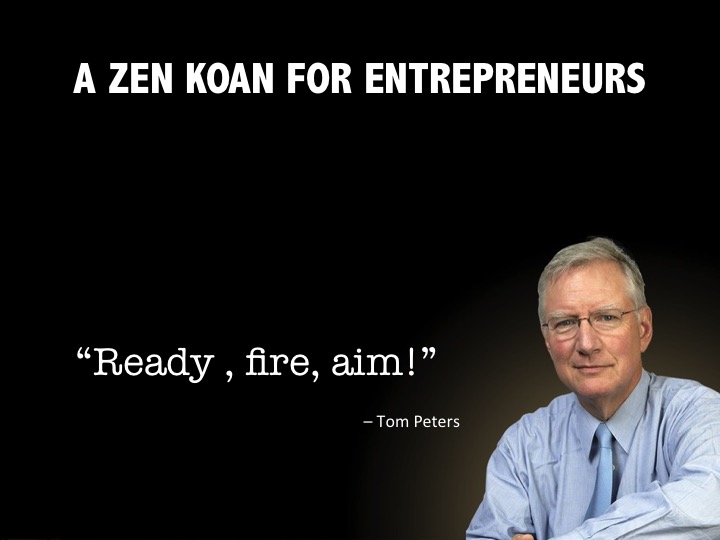
TomPeters.com
MitchDitkoff.com
Posted by Mitch Ditkoff at 01:51 PM | Comments (0)
April 01, 2017KEYNOTE: Storytelling at Work

THIS JUST IN! There is a very good chance that the dominant story being told in your organization these days is an old one -- a narrative that binds your enterprise to the past. Not a good idea.
As Steve Jobs once said, "The most powerful person in the world is the storyteller. The storyteller sets the vision, value, and agenda for an entire generation to come."
Clearly, Jobs walked his talk. The stories he told ended up shaping the lives of millions of people around the world. Well, then, what stories are your people telling? And if the stories they're telling are not setting the vision, values, and agenda for an entire generation to come (or at least your business or industry), then something needs to shift. And I can catalyze that shift in 90 minutes or less.
Storytelling at Work is the simple, compelling way to open minds, build community, spark innovation, and accelerate the sharing of tacit knowledge -- the hard-to-communicate brilliance that is the DNA of your organization's success. My keynote includes copies of my award-winning book Storytelling at Work and at least a few "off the record" stories I will tell at the bar later that night.
Posted by Mitch Ditkoff at 05:47 AM | Comments (0)




